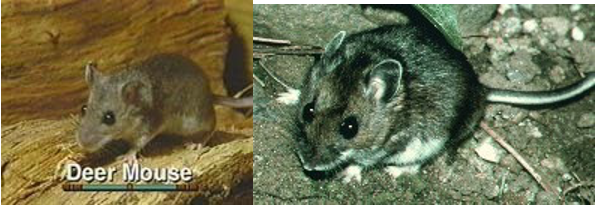Preventing Hanta Virus Infection and Lyme Disease
This is the time of year for cleaning garages, spaces underneath houses, and mountain/island cabins. These spaces are often visited by critters such as deer mice which leave droppings that may harbor the infectious agent that causes Hanta Virus Pulmonary Syndrome. Summer hikes and wanderings in meadows is the time a person may encounter the tick that carries Lyme Disease. Hanta Virus PS and Lyme Disease are vector-borne diseases, meaning they are diseases that are transmitted from a host to another susceptible host by a biological agent, often an insect. Although the incidence of Hanta Virus PS and Lyme Disease is low in Washington State, occurring mostly in rural areas, knowledge about the vectors, symptoms of infection, and the means for preventing infection are good public health measures to consider.
Hantavirus Pulmonary Syndrome (Hantavirus PS)
Infected deer mice (probably about 14% of deer mice are infected) excrete the virus in their urine, saliva, and droppings. A person may be exposed to hanta virus by breathing contaminated dust after disturbing or cleaning rodent droppings or nests, or by living or working in rodent-infested settings. People may touch something contaminated with rodent urine, droppings, or saliva and then they touch their nose or mouth, or eat food contaminated with virus infected urine/droppings/saliva. Typically one to five cases are reported each year. Since infected deer mice live throughout the state, human cases of hanta virus pulmonary syndrome can occur. Between 1993 and 2009, forty (40) cases were reported with13 (33%) associated deaths. Data for 2009 listed three reported cases (one death); two exposures were in eastern Washington and one in northern California.
Vectors that transmit types of Hantavirus Pulmonary Syndrome include deer mice, cotton rat, rice rat, and white footed mouse. A deer mouse is 4-9 inches long from head to tip of tail. It is pale gray to reddish brown and has white fur on its belly, feet, and underside of the tail. It has oversized ears.

Symptoms of Hanta Virus
The symptoms of Hanta Virus usually appear within 2 weeks of infection but can appear as early as 3 days to as late as 6 weeks after infection. First symptoms are general and flu-like. They can include fever (101-104 F), headache, abdominal, joint and lower back pain. Sometimes nausea and vomiting also occur. The primary symptom of this disease is difficulty in breathing, which is caused by fluid build-up in the lungs and quickly progresses to an inability to breathe. Hantavirus is not spread from person to person. The virus, which is able to survive in the environment (for example, in contaminated dirt and dust), can be killed by most household disinfectants, such as bleach and alcohol.
How to identify mouse burrows
A mouse nest (burrow) is usually a pile of material under which the mouse lives. This pile can contain many different materials, such as twigs, insulation, styrofoam and grass.
Minimize the risk for hantavirus infection by following these precautions as suggested by CDC:
- Before occupying abandoned or unused cabins, open them up to air them out. Inspect for rodents and do not use cabins if you find signs of rodent infestation.
- If you sleep outdoors, check potential campsites for rodent droppings and burrows.
- Do not disturb rodents, burrows, or dens.
- Avoid sleeping near woodpiles or garbage areas that may be frequented by rodents.
- Avoid sleeping on bare ground, use a mat or elevated cots if they are available.
- Store foods in rodent-proof containers and promptly discard, bury, or burn all garbage.
In addition, when cleaning a garage/basement/cabin and you see mouse droppings, avoid sweeping with a broom (this creates dust). Use bleach and water to clean where you see droppings.
Lyme Disease
Only zero to 3 Lyme disease cases per year are reported in Washington. Lyme disease is caused by the Borrelia burgdorferi bacterium, which can be transmitted through the bite of a western black-legged tick, Ixodes pacificus. Western black-legged ticks pick up the bacteria after feeding on infected rodents. These ticks live in forested or brushy areas of western Washington. Ticks most commonly infected with the bacterium usually feed and mate on deer during part of their life cycle. ()


Common Symptoms of Lyme Disease occur within 3 to 30 days following a deer tick bite.
Symptoms include rash (erythema migrans), fever, chills, headache, muscle and joint aches, and fatigue. Other symptoms may include facial paralysis (Bell's palsy), meningitis, and brief episodes of joint pain and swelling. Late infection may include arthritis (intermittent or chronic); less common is mental confusion or encephalitis (inflammation of brain tissue).
Cabins and rodents
When staying in summer cabins or vacation homes, especially in eastern Washington, make sure rodents, and their ticks, aren't spending the night with you. Practice rodent control by not attracting rodents, sealing them out of living areas, trapping rodents, and properly cleaning up rodent-contaminated areas.
What can you do about ticks?
When hiking in potential tick areas, wear clothing that covers bare arms and legs. If detected on skin, pull out gently with tweezers, taking care not to squeeze the tick's body and apply antiseptic to the bite. Prompt removal can prevent disease. Note: immature ticks are about size of a poppy seed.
| Disease | Causative Agent | Vector | Method of Infection |
|---|---|---|---|
| Hanta-virus PS | Hanta virus | deer mice, cotton rat | mainly air |
| Cholera | Bacterium | house fly | foods |
| Malaria | Protozoan | Anopheles mosquito | Bite |
| Lyme D. | Spirochete | deer tick | Bite |
| Typhoid | Salmonella | house fly | food & water |
Have a Healthy, Happy, Safe and Fun-Thrilled Summer!